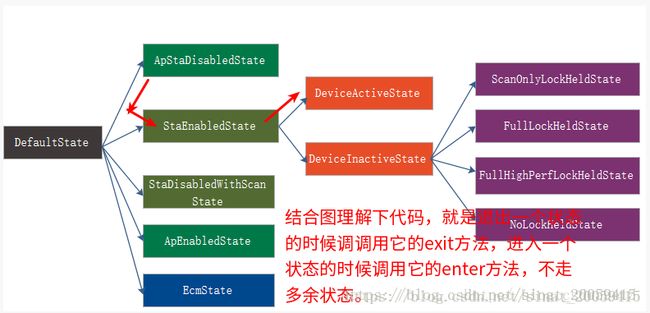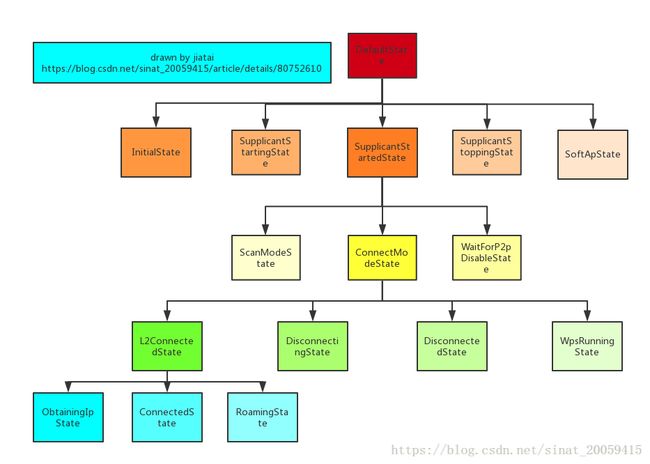(七十一)Android O WiFi热点 开启流程梳理
前言:之前主要梳理了WiFi开启扫描连接的流程,现在梳理下WiFi 热点 的开启流程。
时序图mdj样式:https://download.csdn.net/download/sinat_20059415/10542186
1. wifi热点简介
wifi热点是将手机接收的GPRS、3G或4G信号转化为wifi信号发出去的技术,手机必须有无线AP功能,才能当做热点。有些系统自带建热点这个功能比如 IOS(比如 iPhone 4s)。
如果你把你的iPhone当做热点,那么像TOUCH,PAD这样有WIFI功能的,都可以搜索到你手机建立的WIFI网络,连接上以后,TOUCH等使用WIFI产生的流量上网都是消耗的乐WIFI里的手机卡的GPRS或3G流量,所以iphone里最好放一张包大流量的上网卡。还有,把手机当做热点很费电,最好用的时候插上充电器。
2. WiFi热点开启流程梳理
2.1 Settings
Android O的Settings引入了PreferenceController这个包装类来实现对Preference的精细化控制,让代码结构更加地鲜明,很好地体现了单一职责原则,以前的Preference都是一大坨代码冗余在一起,看的都头疼。
TetherSettings->WifiTetherPreferenceController->WifiTetherSwitchBarController
TetherSettings是WiFi热点对应的界面,WifiTetherSwitchBarController是用来负责热点开关的相关逻辑处理的。
/packages/apps/Settings/src/com/android/settings/wifi/tether/WifiTetherSwitchBarController.java
public class WifiTetherSwitchBarController implements SwitchWidgetController.OnSwitchChangeListener,
LifecycleObserver, OnStart, OnStop {
...
@Override
public boolean onSwitchToggled(boolean isChecked) {
if (isChecked) {
startTether();
} else {
stopTether();
}
return true;
}
void stopTether() {
mSwitchBar.setEnabled(false);
mConnectivityManager.stopTethering(TETHERING_WIFI);
}
void startTether() {
mSwitchBar.setEnabled(false);
mConnectivityManager.startTethering(TETHERING_WIFI, true /* showProvisioningUi */,
NoOpOnStartTetheringCallback.newInstance(), new Handler(Looper.getMainLooper()));
}可以看到WiFi热点代开是通过ConnectivityManager的startTethering方法。
附
1) callback(抽象类直接new出来的,内部实现还没有。。。)
class NoOpOnStartTetheringCallback {
public static ConnectivityManager.OnStartTetheringCallback newInstance() {
return new ConnectivityManager.OnStartTetheringCallback() {
};
}
}
/**
* Callback for use with {@link #startTethering} to find out whether tethering succeeded.
* @hide
*/
@SystemApi
public static abstract class OnStartTetheringCallback {
/**
* Called when tethering has been successfully started.
*/
public void onTetheringStarted() {}
/**
* Called when starting tethering failed.
*/
public void onTetheringFailed() {}
}
2)状态监听:
private final BroadcastReceiver mReceiver = new BroadcastReceiver() {
@Override
public void onReceive(Context context, Intent intent) {
String action = intent.getAction();
if (WifiManager.WIFI_AP_STATE_CHANGED_ACTION.equals(action)) {
final int state = intent.getIntExtra(
WifiManager.EXTRA_WIFI_AP_STATE, WifiManager.WIFI_AP_STATE_FAILED);
handleWifiApStateChanged(state);
} else if (Intent.ACTION_AIRPLANE_MODE_CHANGED.equals(action)) {
enableWifiSwitch();
}
}
};
private void handleWifiApStateChanged(int state) {
switch (state) {
case WifiManager.WIFI_AP_STATE_ENABLING:
mSwitchBar.setEnabled(false);
break;
case WifiManager.WIFI_AP_STATE_ENABLED:
if (!mSwitchBar.isChecked()) {
mSwitchBar.setChecked(true);
}
enableWifiSwitch();
break;
case WifiManager.WIFI_AP_STATE_DISABLING:
if (mSwitchBar.isChecked()) {
mSwitchBar.setChecked(false);
}
mSwitchBar.setEnabled(false);
break;
case WifiManager.WIFI_AP_STATE_DISABLED:
mSwitchBar.setChecked(false);
enableWifiSwitch();
break;
default:
mSwitchBar.setChecked(false);
enableWifiSwitch();
break;
}
}
private void enableWifiSwitch() {
boolean isAirplaneMode = Settings.Global.getInt(mContext.getContentResolver(),
Settings.Global.AIRPLANE_MODE_ON, 0) != 0;
if (!isAirplaneMode) {
mSwitchBar.setEnabled(!mDataSaverBackend.isDataSaverEnabled());
} else {
mSwitchBar.setEnabled(false);
}
}
2.2 ConnectivityManager
/**
* Runs tether provisioning for the given type if needed and then starts tethering if
* the check succeeds. If no carrier provisioning is required for tethering, tethering is
* enabled immediately. If provisioning fails, tethering will not be enabled. It also
* schedules tether provisioning re-checks if appropriate.
*
* @param type The type of tethering to start. Must be one of
* {@link ConnectivityManager.TETHERING_WIFI},
* {@link ConnectivityManager.TETHERING_USB}, or
* {@link ConnectivityManager.TETHERING_BLUETOOTH}.
* @param showProvisioningUi a boolean indicating to show the provisioning app UI if there
* is one. This should be true the first time this function is called and also any time
* the user can see this UI. It gives users information from their carrier about the
* check failing and how they can sign up for tethering if possible.
* @param callback an {@link OnStartTetheringCallback} which will be called to notify the caller
* of the result of trying to tether.
* @param handler {@link Handler} to specify the thread upon which the callback will be invoked.
* @hide
*/
@SystemApi
@RequiresPermission(android.Manifest.permission.TETHER_PRIVILEGED)
public void startTethering(int type, boolean showProvisioningUi,
final OnStartTetheringCallback callback, Handler handler) {
Preconditions.checkNotNull(callback, "OnStartTetheringCallback cannot be null.");
ResultReceiver wrappedCallback = new ResultReceiver(handler) {
@Override
protected void onReceiveResult(int resultCode, Bundle resultData) {
if (resultCode == TETHER_ERROR_NO_ERROR) {
callback.onTetheringStarted();
} else {
callback.onTetheringFailed();
}
}
};
try {
String pkgName = mContext.getOpPackageName();
Log.i(TAG, "startTethering caller:" + pkgName);
mService.startTethering(type, wrappedCallback, showProvisioningUi, pkgName);
} catch (RemoteException e) {
Log.e(TAG, "Exception trying to start tethering.", e);
wrappedCallback.send(TETHER_ERROR_SERVICE_UNAVAIL, null);
}
}至于mService:
mConnectivityManager =
(ConnectivityManager) context.getSystemService(Context.CONNECTIVITY_SERVICE);SystemServiceRegistry:
registerService(Context.CONNECTIVITY_SERVICE, ConnectivityManager.class,
new StaticApplicationContextServiceFetcher() {
@Override
public ConnectivityManager createService(Context context) throws ServiceNotFoundException {
IBinder b = ServiceManager.getServiceOrThrow(Context.CONNECTIVITY_SERVICE);
IConnectivityManager service = IConnectivityManager.Stub.asInterface(b);
return new ConnectivityManager(context, service);
}}); /**
* {@hide}
*/
public ConnectivityManager(Context context, IConnectivityManager service) {
mContext = Preconditions.checkNotNull(context, "missing context");
mService = Preconditions.checkNotNull(service, "missing IConnectivityManager");
sInstance = this;
}SystemServer:
traceBeginAndSlog("StartConnectivityService");
try {
connectivity = new ConnectivityService(
context, networkManagement, networkStats, networkPolicy);
ServiceManager.addService(Context.CONNECTIVITY_SERVICE, connectivity);
networkStats.bindConnectivityManager(connectivity);
networkPolicy.bindConnectivityManager(connectivity);
} catch (Throwable e) {
reportWtf("starting Connectivity Service", e);
}
traceEnd();
所以mService是ConnectivityService。
2.3 ConnectivityService
@Override
public void startTethering(int type, ResultReceiver receiver, boolean showProvisioningUi,
String callerPkg) {
ConnectivityManager.enforceTetherChangePermission(mContext, callerPkg);
if (!isTetheringSupported()) {
receiver.send(ConnectivityManager.TETHER_ERROR_UNSUPPORTED, null);
return;
}
mTethering.startTethering(type, receiver, showProvisioningUi);
}
2.4 Tethering
public void startTethering(int type, ResultReceiver receiver, boolean showProvisioningUi) {
if (!isTetherProvisioningRequired()) {
enableTetheringInternal(type, true, receiver);
return;
}
if (showProvisioningUi) {
runUiTetherProvisioningAndEnable(type, receiver);
} else {
runSilentTetherProvisioningAndEnable(type, receiver);
}
}暂时先认为打开tethering需要provision吧,继续往下看。
/**
* Check if the device requires a provisioning check in order to enable tethering.
*
* @return a boolean - {@code true} indicating tether provisioning is required by the carrier.
*/
@VisibleForTesting
protected boolean isTetherProvisioningRequired() {
final TetheringConfiguration cfg = mConfig;
if (mSystemProperties.getBoolean(DISABLE_PROVISIONING_SYSPROP_KEY, false)
|| cfg.provisioningApp.length == 0) {
return false;
}
if (carrierConfigAffirmsEntitlementCheckNotRequired()) {
return false;
}
return (cfg.provisioningApp.length == 2);
}shouProvisioningUi由设置传入,是true
private void runUiTetherProvisioningAndEnable(int type, ResultReceiver receiver) {
ResultReceiver proxyReceiver = getProxyReceiver(type, receiver);
sendUiTetherProvisionIntent(type, proxyReceiver);
} /**
* Creates a proxy {@link ResultReceiver} which enables tethering if the provisioning result
* is successful before firing back up to the wrapped receiver.
*
* @param type The type of tethering being enabled.
* @param receiver A ResultReceiver which will be called back with an int resultCode.
* @return The proxy receiver.
*/
private ResultReceiver getProxyReceiver(final int type, final ResultReceiver receiver) {
ResultReceiver rr = new ResultReceiver(null) {
@Override
protected void onReceiveResult(int resultCode, Bundle resultData) {
// If provisioning is successful, enable tethering, otherwise just send the error.
if (resultCode == TETHER_ERROR_NO_ERROR) {
enableTetheringInternal(type, true, receiver);
} else {
sendTetherResult(receiver, resultCode);
}
}
};
// The following is necessary to avoid unmarshalling issues when sending the receiver
// across processes.
Parcel parcel = Parcel.obtain();
rr.writeToParcel(parcel,0);
parcel.setDataPosition(0);
ResultReceiver receiverForSending = ResultReceiver.CREATOR.createFromParcel(parcel);
parcel.recycle();
return receiverForSending;
} private void sendUiTetherProvisionIntent(int type, ResultReceiver receiver) {
Intent intent = new Intent(Settings.ACTION_TETHER_PROVISIONING);
intent.putExtra(EXTRA_ADD_TETHER_TYPE, type);
intent.putExtra(EXTRA_PROVISION_CALLBACK, receiver);
intent.addFlags(Intent.FLAG_ACTIVITY_NEW_TASK);
final long ident = Binder.clearCallingIdentity();
try {
mContext.startActivityAsUser(intent, UserHandle.CURRENT);
} finally {
Binder.restoreCallingIdentity(ident);
}
}Settings有如下类会接收并处理消息
/**
* Activity which acts as a proxy to the tether provisioning app for sanity checks and permission
* restrictions. Specifically, the provisioning apps require
* {@link android.permission.CONNECTIVITY_INTERNAL}, while this activity can be started by a caller
* with {@link android.permission.TETHER_PRIVILEGED}.
*/
public class TetherProvisioningActivity extends Activity {
private static final int PROVISION_REQUEST = 0;
private static final String TAG = "TetherProvisioningAct";
private static final String EXTRA_TETHER_TYPE = "TETHER_TYPE";
private static final boolean DEBUG = Log.isLoggable(TAG, Log.DEBUG);
private ResultReceiver mResultReceiver;
@Override
public void onCreate(Bundle savedInstanceState) {
super.onCreate(savedInstanceState);
mResultReceiver = (ResultReceiver)getIntent().getParcelableExtra(
ConnectivityManager.EXTRA_PROVISION_CALLBACK);
int tetherType = getIntent().getIntExtra(ConnectivityManager.EXTRA_ADD_TETHER_TYPE,
ConnectivityManager.TETHERING_INVALID);
String[] provisionApp = getResources().getStringArray(
com.android.internal.R.array.config_mobile_hotspot_provision_app);
Intent intent = new Intent(Intent.ACTION_MAIN);
intent.setClassName(provisionApp[0], provisionApp[1]);
intent.putExtra(EXTRA_TETHER_TYPE, tetherType);
if (DEBUG) {
Log.d(TAG, "Starting provisioning app: " + provisionApp[0] + "." + provisionApp[1]);
}
if (getPackageManager().queryIntentActivities(intent,
PackageManager.MATCH_DEFAULT_ONLY).isEmpty()) {
Log.e(TAG, "Provisioning app is configured, but not available.");
mResultReceiver.send(ConnectivityManager.TETHER_ERROR_PROVISION_FAILED, null);
finish();
return;
}
startActivityForResultAsUser(intent, PROVISION_REQUEST, UserHandle.CURRENT);
}
@Override
public void onActivityResult(int requestCode, int resultCode, Intent intent) {
super.onActivityResult(requestCode, resultCode, intent);
if (requestCode == PROVISION_REQUEST) {
if (DEBUG) Log.d(TAG, "Got result from app: " + resultCode);
int result = resultCode == Activity.RESULT_OK ?
ConnectivityManager.TETHER_ERROR_NO_ERROR :
ConnectivityManager.TETHER_ERROR_PROVISION_FAILED;
mResultReceiver.send(result, null);
finish();
}
}
}具体provision app需要vendor具体配置,看framework/base/core/res/res是空的
./values/config.xml:407:
./values/config.xml-408-
./values/config.xml-412- 完成后回调onActivityResult,发送ConnectivityManager.TETHER_ERROR_NO_ERROR,继续调用enableTetheringInternal方法。
ResultReceiver rr = new ResultReceiver(null) {
@Override
protected void onReceiveResult(int resultCode, Bundle resultData) {
// If provisioning is successful, enable tethering, otherwise just send the error.
if (resultCode == TETHER_ERROR_NO_ERROR) {
enableTetheringInternal(type, true, receiver);
} else {
sendTetherResult(receiver, resultCode);
}
}
};
/**
* Enables or disables tethering for the given type. This should only be called once
* provisioning has succeeded or is not necessary. It will also schedule provisioning rechecks
* for the specified interface.
*/
private void enableTetheringInternal(int type, boolean enable, ResultReceiver receiver) {
boolean isProvisioningRequired = enable && isTetherProvisioningRequired();
int result;
switch (type) {
case TETHERING_WIFI:
result = setWifiTethering(enable);
if (isProvisioningRequired && result == TETHER_ERROR_NO_ERROR) {
scheduleProvisioningRechecks(type);
}
sendTetherResult(receiver, result);
break;
case TETHERING_USB:
result = setUsbTethering(enable);
if (isProvisioningRequired && result == TETHER_ERROR_NO_ERROR) {
scheduleProvisioningRechecks(type);
}
sendTetherResult(receiver, result);
break;
case TETHERING_BLUETOOTH:
setBluetoothTethering(enable, receiver);
break;
default:
Log.w(TAG, "Invalid tether type.");
sendTetherResult(receiver, TETHER_ERROR_UNKNOWN_IFACE);
}
}可以看到tethering不特指WiFi热点,总体包含蓝牙WiFi热点和Usb。
我们还是走不需要provision的流程把。。。
private int setWifiTethering(final boolean enable) {
int rval = TETHER_ERROR_MASTER_ERROR;
final long ident = Binder.clearCallingIdentity();
try {
synchronized (mPublicSync) {
mWifiTetherRequested = enable;
final WifiManager mgr = getWifiManager();
if ((enable && mgr.startSoftAp(null /* use existing wifi config */)) ||
(!enable && mgr.stopSoftAp())) {
rval = TETHER_ERROR_NO_ERROR;
}
}
} finally {
Binder.restoreCallingIdentity(ident);
}
return rval;
}这边会走到WifiManager里去,wifi config为空表示使用已有的WiFi config。后面的senTetherResult就是回调之前的receiver通知执行结果。
2.5 WifiManager
/**
* Start SoftAp mode with the specified configuration.
* Note that starting in access point mode disables station
* mode operation
* @param wifiConfig SSID, security and channel details as
* part of WifiConfiguration
* @return {@code true} if the operation succeeds, {@code false} otherwise
*
* @hide
*/
public boolean startSoftAp(@Nullable WifiConfiguration wifiConfig) {
try {
return mService.startSoftAp(wifiConfig);
} catch (RemoteException e) {
throw e.rethrowFromSystemServer();
}
}
2.6 WifiServiceImpl
/**
* see {@link android.net.wifi.WifiManager#startSoftAp(WifiConfiguration)}
* @param wifiConfig SSID, security and channel details as part of WifiConfiguration
* @return {@code true} if softap start was triggered
* @throws SecurityException if the caller does not have permission to start softap
*/
@Override
public boolean startSoftAp(WifiConfiguration wifiConfig) {
// NETWORK_STACK is a signature only permission.
enforceNetworkStackPermission();
mLog.info("startSoftAp uid=%").c(Binder.getCallingUid()).flush();
synchronized (mLocalOnlyHotspotRequests) {
// If a tethering request comes in while we have LOHS running (or requested), call stop
// for softap mode and restart softap with the tethering config.
if (!mLocalOnlyHotspotRequests.isEmpty()) {
stopSoftApInternal();
}
return startSoftApInternal(wifiConfig, WifiManager.IFACE_IP_MODE_TETHERED);
}
}
/**
* Internal method to start softap mode. Callers of this method should have already checked
* proper permissions beyond the NetworkStack permission.
*/
private boolean startSoftApInternal(WifiConfiguration wifiConfig, int mode) {
mLog.trace("startSoftApInternal uid=% mode=%")
.c(Binder.getCallingUid()).c(mode).flush();
// null wifiConfig is a meaningful input for CMD_SET_AP
if (wifiConfig == null || isValid(wifiConfig)) {
SoftApModeConfiguration softApConfig = new SoftApModeConfiguration(mode, wifiConfig);
mWifiController.sendMessage(CMD_SET_AP, 1, 0, softApConfig);
return true;
}
Slog.e(TAG, "Invalid WifiConfiguration");
return false;
}这边对空的wificonfig包装成了SoftApModeConfiguration接由WifiController处理。
/**
* Enqueue a message to this state machine.
*
* Message is ignored if state machine has quit.
*/
public void sendMessage(int what, int arg1, int arg2, Object obj) {
// mSmHandler can be null if the state machine has quit.
SmHandler smh = mSmHandler;
if (smh == null) return;
smh.sendMessage(obtainMessage(what, arg1, arg2, obj));
}
2.7 WifiController
ApStaDisabledState会对该消息进行对应的处理
case CMD_SET_AP:
if (msg.arg1 == 1) {
if (msg.arg2 == 0) { // previous wifi state has not been saved yet
mSettingsStore.setWifiSavedState(WifiSettingsStore.WIFI_DISABLED);
}
mWifiStateMachine.setHostApRunning((SoftApModeConfiguration) msg.obj,
true);
transitionTo(mApEnabledState);
}
break;
2.8 WifiStateMachine
/**
* TODO: doc
*/
public void setHostApRunning(SoftApModeConfiguration wifiConfig, boolean enable) {
if (enable) {
sendMessage(CMD_START_AP, wifiConfig);
} else {
sendMessage(CMD_STOP_AP);
}
}
看了一圈只有InitialState对该消息有正确响应
case CMD_START_AP:
transitionTo(mSoftApState);
break;InitialState exit()方法为空,看下SoftApState的enter方法
class SoftApState extends State {
private SoftApManager mSoftApManager;
private String mIfaceName;
private int mMode;
private class SoftApListener implements SoftApManager.Listener {
@Override
public void onStateChanged(int state, int reason) {
if (state == WIFI_AP_STATE_DISABLED) {
sendMessage(CMD_AP_STOPPED);
} else if (state == WIFI_AP_STATE_FAILED) {
sendMessage(CMD_START_AP_FAILURE);
}
setWifiApState(state, reason, mIfaceName, mMode);
}
}
@Override
public void enter() {
final Message message = getCurrentMessage();
if (message.what != CMD_START_AP) {
throw new RuntimeException("Illegal transition to SoftApState: " + message);
}
SoftApModeConfiguration config = (SoftApModeConfiguration) message.obj;
mMode = config.getTargetMode();
IApInterface apInterface = null;
Pair statusAndInterface = mWifiNative.setupForSoftApMode();
if (statusAndInterface.first == WifiNative.SETUP_SUCCESS) {
apInterface = statusAndInterface.second;
} else {
incrementMetricsForSetupFailure(statusAndInterface.first);
}
if (apInterface == null) {
setWifiApState(WIFI_AP_STATE_FAILED,
WifiManager.SAP_START_FAILURE_GENERAL, null, mMode);
/**
* Transition to InitialState to reset the
* driver/HAL back to the initial state.
*/
transitionTo(mInitialState);
return;
}
try {
mIfaceName = apInterface.getInterfaceName();
} catch (RemoteException e) {
// Failed to get the interface name. The name will not be available for
// the enabled broadcast, but since we had an error getting the name, we most likely
// won't be able to fully start softap mode.
}
checkAndSetConnectivityInstance();
mSoftApManager = mWifiInjector.makeSoftApManager(mNwService,
new SoftApListener(),
apInterface,
config.getWifiConfiguration());
mSoftApManager.start();
mWifiStateTracker.updateState(WifiStateTracker.SOFT_AP);
}
这边的调用流程和WiFi的启动流程有点类似。先梳理到这,后面应该是硬菜。。。




